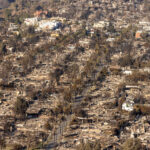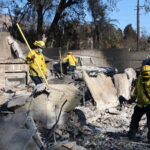Back when Donald Perovich, an engineering professor at Dartmouth and member of the MOSAiC Arctic research team, conducted his first sea-ice field experiment in the region in 1979, he and his colleagues didn’t study ice because they were worried about climate change. They studied it because it was there.
“When it started out, it was scientifically very challenging,” he said. “From just a personal perspective, the adventure was really awesome.”
Perovich is also an author of the U.S. National Oceanic and Atmospheric Administration’s 2020 Arctic Report Card, published today, which documents how rising temperatures are ravaging the top of the world. He led the chapter on Arctic sea ice, which a warm spring and early summer pushed to its second-lowest summer minimum in 42 years.
Arctic sea-ice has been falling by an average of 13% per decade since 1979, with precipitous drops now and then; this year, floating ice continued to shrink under the second-highest Arctic temperatures recorded since 1900. The heat left the Arctic portion of the Eurasian land mass with its lowest June snow cover in 54 years. Northeastern Russia saw unprecedented wildfires, and Verkhoyansk, a town in that region, experienced the highest-ever temperature north of the Arctic circle, reaching 100.4°F (38°C) in June. Glaciers in Greenland continued to shed water at a rate above the long-term average but below last year’s peak.
Northern ecosystems are changing—not always for the worse, depending on the species. Warmer waters have drawn plankton toward the top of the world, leading to a prodigious increase in the living mass of Arctic waters. Bowhead whales—a staple food source for indigenous peoples for millennia until they were hunted nearly to extinction in the previous two centuries—have consequently bounced back to their early-19th century population levels.
The MOSAiC expedition, which NOAA was involved in from its inception, generated a library of data that scientists are only now digging into. The project monitored the atmosphere, ocean, ecosystems and marine chemistry, all atop a sea-ice pack bearing scars from decades of accelerating heat. It wasn’t an easy mission to pull off. “Challenges started with simply finding an ice floe to moor the ship and conduct observations, as the ice in the target region was thinner than expected,” the report states.
The observations taken over MOSAiC’s year in the Arctic now sit with dozens of scientists, who will analyze them in part to help improve the climate models that project what warming may do next to the region—and the world below it.
Perovich wasn’t on the MOSAiC’s ship—he contributed remotely. But he still recalls his time on board the SHEBA project, a similar yearlong polar expedition in the late 90s, on which he served as chief scientist. “Every year around the beginning of October, I look at the ice maps to see where we started” in 1997, he said. “It’s just been open ocean. We would have had to go hundreds of miles further north.”
For the 15th anniversary edition of NOAA’s Arctic Report Card, the authors reflected specifically on this decade and a half. In an essay, they wrote that the “2007 September minimum sea ice extent stunned scientists,” with a 23% drop over the previous record low set in 2005.
The ice has never returned to its pre-2007 levels.
“It’s just amazing how much ice has been lost,” Perovich said. “You don’t expect to see something that, in my mind, was a geological-time process, melting away during a human lifetime.”
Was this article valuable?
Here are more articles you may enjoy.


 Catastrophe Experts Tap AI to Tackle Soaring Insured Losses
Catastrophe Experts Tap AI to Tackle Soaring Insured Losses  Bankrupt 23andMe’s DNA Data Gets Sale Nod as Concerns Linger
Bankrupt 23andMe’s DNA Data Gets Sale Nod as Concerns Linger  Auto Insurer Fined for Data Breach That Impacted 45K New Yorkers
Auto Insurer Fined for Data Breach That Impacted 45K New Yorkers  New Fire Maps Put Nearly 4M Californians in Hazardous Zones
New Fire Maps Put Nearly 4M Californians in Hazardous Zones 